Full sun flower beds offer some of the most exciting opportunities in garden design, allowing you to showcase a spectacular array of colorful blooms that thrive in bright conditions. These sun-drenched spaces can become the crown jewels of your landscape when thoughtfully planned and executed.
Creating successful full sun flower beds requires understanding both the challenges and advantages these locations present. With 6+ hours of direct sunlight daily, these areas can support the most prolific flowering plants available to home gardeners, but they also demand careful consideration of factors like drought tolerance, heat resistance, and strategic planting to maintain visual interest throughout the growing season.
Whether you’re designing a brand new garden space or rejuvenating an existing bed, full sun locations offer tremendous potential for dramatic seasonal displays that attract pollinators, provide cutting flowers, and create focal points within your landscape. By incorporating a thoughtful mix of annuals, perennials, flowering shrubs, and architectural elements, you can transform these sunny spots into showcase gardens that deliver beauty with manageable maintenance requirements.
In the following sections, we’ll explore design principles, plant selection strategies, and practical tips to help you create full sun flower beds that maximize visual impact while minimizing maintenance challenges.
1. PETUNIAS
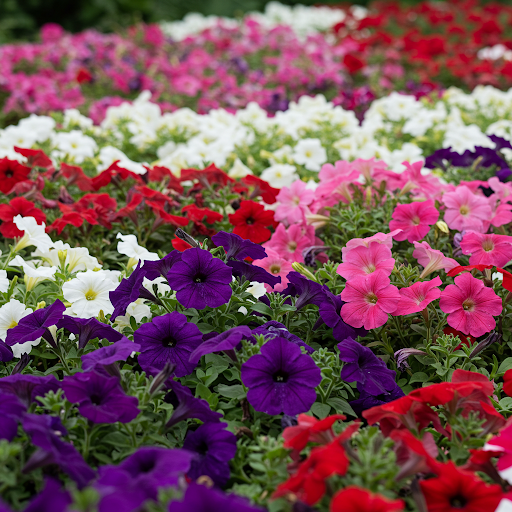
Petunias rank among the most versatile and beloved sun-loving annuals, offering remarkable variety in both growth habit and color palette. These flowering powerhouses deliver continuous blooms from spring until frost with minimal maintenance requirements.
Key characteristics:
- Suitable for all planting zones as seasonal annuals
- Available in an extensive color range including white, pink, lavender, purple, bicolor, yellow, salmon, and more
- Tolerant of temperatures down to 39°F (frost will damage or kill plants)
- Disease-resistant and easy to establish
- Budget-friendly and readily available at garden centers
- Versatile for borders, hanging baskets, and container gardening
- Continuous flowering throughout summer with proper deadheading
- Growth range of 8-18 inches wide and 6-24 inches tall depending on variety
Design tip: Create dynamic container compositions by combining petunias with vertical salvia, textural dusty miller, bold zinnias, and trailing potato vines. For landscape impact, mass petunias in borders for sweeping waves of summer-long color.
2. STRAWFLOWERS
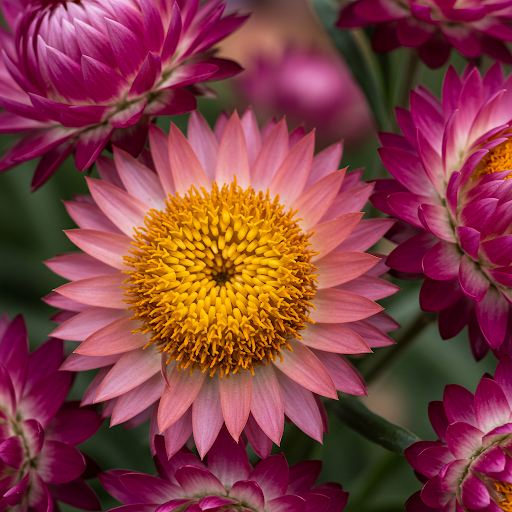
Strawflowers (Xerochrysum bracteatum) offer not only vibrant garden displays but also excellent options for cutting gardens and dried flower arrangements. Their distinctive papery petals maintain their structure and color even when dried, making them multipurpose garden additions.
Key characteristics:
- Members of the daisy family (Asteraceae)
- Available in vibrant pinks, yellows, oranges, whites, and bicolors
- Excellent for fresh and dried flower arrangements
- Adaptable to most growing zones after frost danger passes
- Drought-tolerant once established
- Easily grown from seed for economical garden planning
- Heliotropic tendencies—flowers will lean toward sunlight in insufficient light
- Distinctive straw-like petal texture that maintains structure when dried
- Performs well in average to poor soil provided drainage is excellent
- Mature height of 24-36 inches, creating vertical interest
Design tip: Maximize visual impact by grouping strawflowers with complementary annuals like petunias and zinnias. Their architectural form and height make them perfect middle-layer plants in mixed borders where they provide textural contrast and vertical structure from summer through fall.
3. ZINNIAS
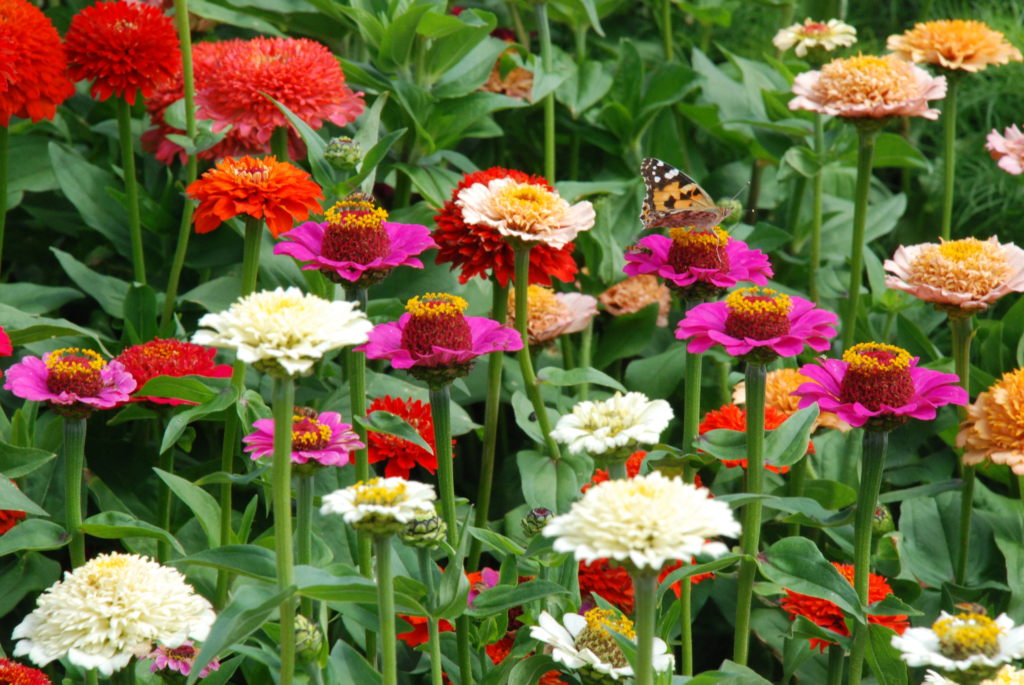
Zinnias epitomize low-maintenance gardening while delivering extraordinary visual reward. Though classified as annuals, their prolific self-seeding habit sometimes results in volunteer plants the following season—a welcome bonus for budget-conscious gardeners.
Key characteristics:
- Adaptable to all growing zones (sow after final frost date)
- Naturally deer-resistant, reducing garden damage concerns
- Exceptional cutting flowers with long vase life
- Available in single, semi-double, and fully double flower forms
- Susceptible to powdery mildew with overcrowding or overhead watering
- Direct-sow seeds for economical garden enhancement
- Pollinator magnets, attracting beneficial bees, butterflies, and hummingbirds
- Non-stop blooming from early summer through mid-fall with deadheading
Design tip: Create textural contrast by pairing zinnias with architectural succulents or aromatic herbs like rosemary. This combination delivers visual interest while the different plant structures help maintain good air circulation, reducing disease pressure on zinnias.
4. CALIBRACHOA

Often marketed as “Million Bells,” calibrachoa delivers extraordinary flowering performance in containers and hanging baskets. While technically classified as annuals in most regions, these versatile plants occasionally overwinter in zones 9-11 and may surprise gardeners in zone 8 with spring reemergence.
Key characteristics:
- Among the most floriferous annuals available to home gardeners
- Extensive color range including yellows, pinks, reds, purples, and bicolors
- Widely available at garden centers and nurseries
- Annual in most zones; potential perennial performance in zones 9-11
- Moderate drought tolerance once established
- Benefits from regular fertilization to maintain vigor and color intensity
- Trailing habit perfect for hanging baskets and container edges
- Compact growth habit that rarely exceeds 12 inches in height
Design tip: Create spectacular container gardens by combining calibrachoa with contrasting foliage plants like silver potato vine and complementary flowering dianthus. This combination delivers textural interest, color harmony, and extended seasonal appeal.
5. SUNFLOWERS
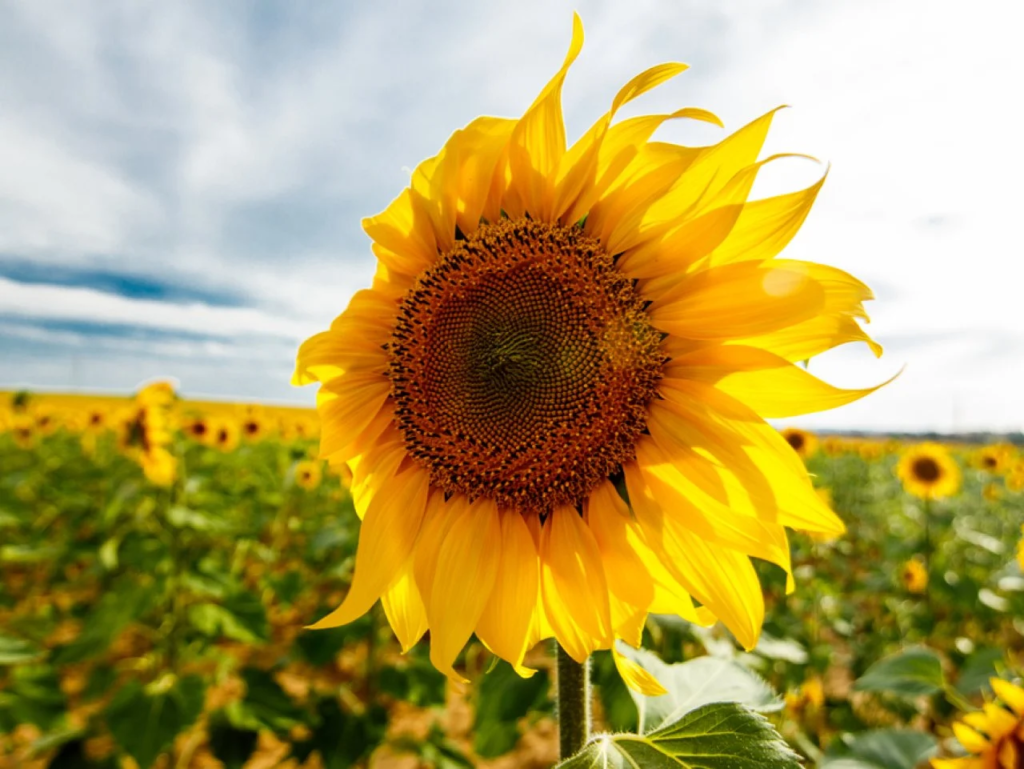
Sunflowers (Helianthus annuus) embody summer’s exuberance with their commanding presence and cheerful appearance. From towering 12-foot specimens to compact border varieties, sunflowers offer versatility beyond their iconic image.
Key characteristics:
- Direct-sow for optimal root development and stability
- Requires adequate spacing (minimum 18 inches) for proper development
- Exhibits heliotropism—flower heads track the sun’s movement
- Thrives in well-drained, nutrient-rich soil
- Adaptable across zones 2-11 with proper timing
- Requires minimum 6-8 hours of direct sunlight daily
- Available in varied heights from dwarf (under 3 feet) to mammoth (over 12 feet)
- Attracts beneficial pollinators and provides seeds for birds
Design tip: Incorporate sunflowers as dramatic focal points in cottage gardens or as living privacy screens during summer months. While primarily grown for garden impact, many varieties also make striking cut flowers with proper conditioning.
6. PORTULACA
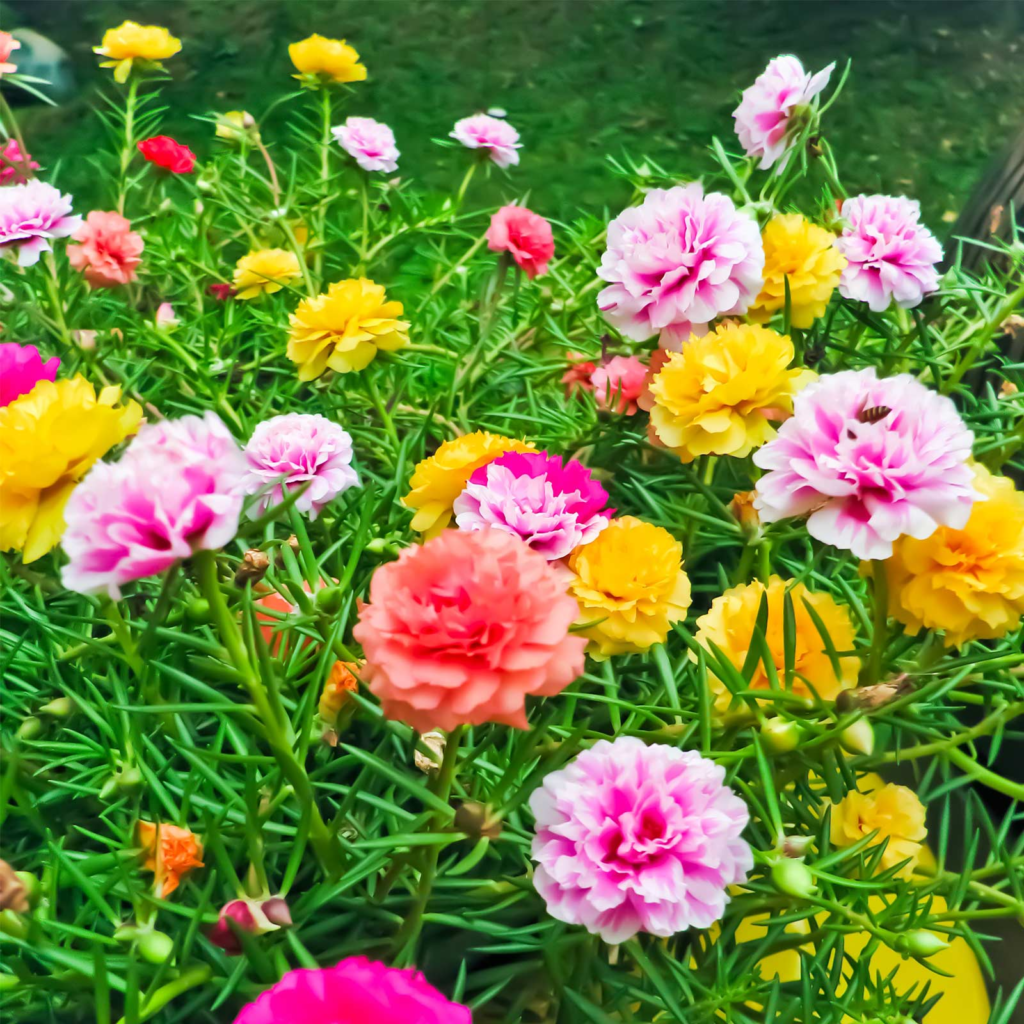
Portulaca (moss rose) demonstrates exceptional resilience in challenging conditions, making it perfect for hot, dry locations where other plants struggle. Its succulent foliage and brilliant flowers create carpets of color in sunny landscapes.
Key characteristics:
- Remarkable color diversity including pink, red, yellow, white, orange, and purple varieties
- Widely available and budget-friendly annual option for all growing zones
- Versatile for hanging baskets, containers, and as heat-tolerant groundcover
- Exceptional drought and heat tolerance with minimal care requirements
- Naturally deer-resistant due to succulent foliage
- Low-growing habit (3-8 inches tall) with spreading tendencies
- Succulent foliage retains moisture during hot periods
- Flowers close in evening or cloudy conditions
Design tip: Maximize portulaca’s impact by using it as a colorful living mulch beneath taller sun-loving plants. Its low maintenance requirements and spreading habit create carpet-like color while suppressing weeds and retaining soil moisture—practical and beautiful gardening.
7. CALENDULA
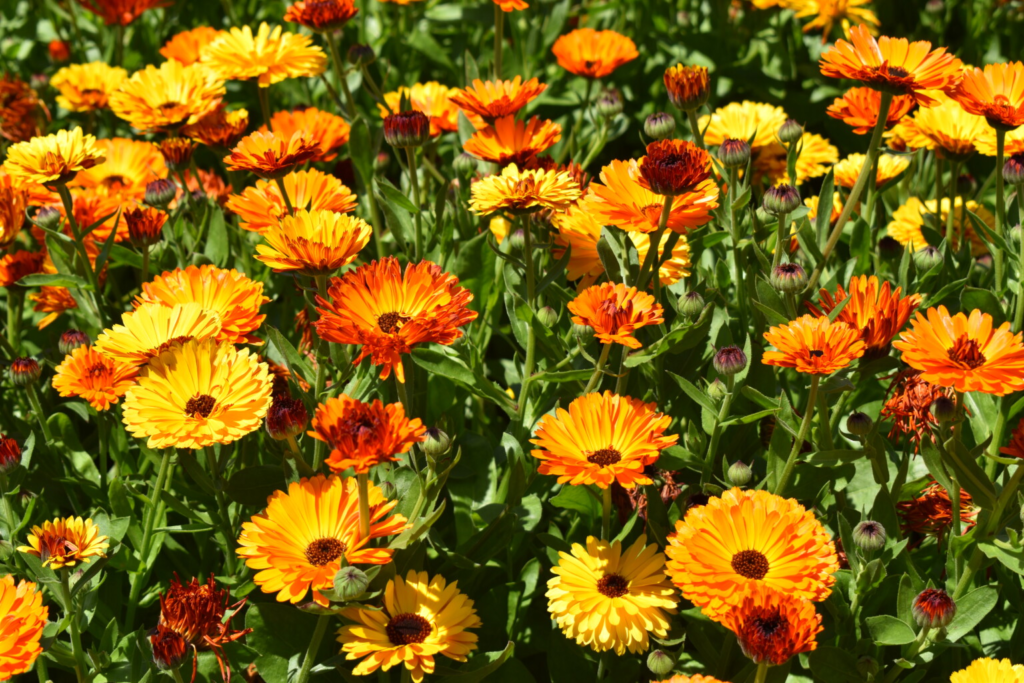
Often called pot marigold, calendula combines ornamental appeal with edible and medicinal properties. These versatile annuals extend the gardening season with their cool-weather tolerance, often blooming well into fall.
Key characteristics:
- Sun-loving annual with edible flower petals
- Adaptable across all growing zones with excellent cool-weather performance
- Variable height range from 9-28 inches depending on variety
- Predominantly available in golden yellow to deep orange color spectrum
- Excellent cutting flowers with good vase life
- Attracts beneficial insects while repelling certain garden pests
- Historic use in culinary and herbal applications
- Self-seeds readily for volunteer plants in subsequent seasons
Design tip: Incorporate calendula into cutting gardens alongside zinnias and sunflowers for season-extending color. Their pest-repelling properties make them excellent companions for vegetable gardens, where they combine functionality with ornamental appeal.
8. MARIGOLDS
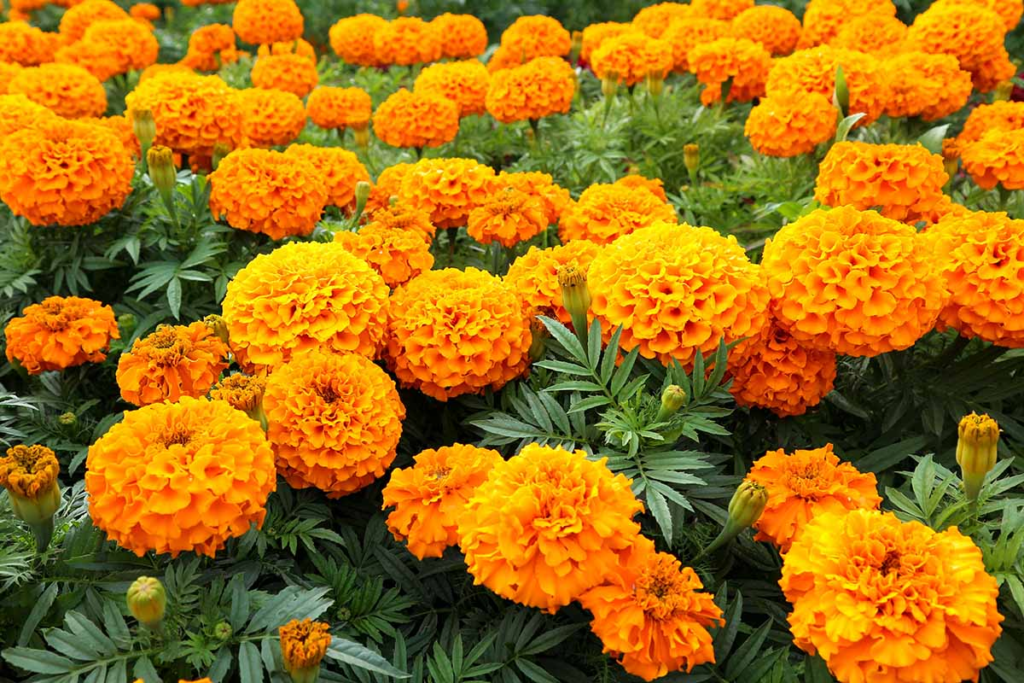
Marigolds deliver reliable performance with minimal maintenance, making them perfect choices for beginning gardeners and seasoned landscapers alike. Their extended blooming season provides color from spring until first frost in most locations.
Key characteristics:
- Adaptable annual for full sun conditions across all growing zones
- Suitable for both garden beds and container plantings
- Excellent cutting flowers for seasonal arrangements
- Continuous blooming with minimal deadheading
- Variable height range from compact varieties (6 inches) to taller specimens (24 inches)
- Color palette spanning golden yellow through deep orange
- Natural pest-deterrent properties beneficial in vegetable gardens
- Strong fragrance that deters many common garden pests
Design tip: Create dynamic visual layering by planting marigolds in front of taller zinnias. This combination not only delivers harmonious color progression but also attracts pollinators and beneficial insects throughout the growing season.
9. IMPATIENS SUNPATIENS
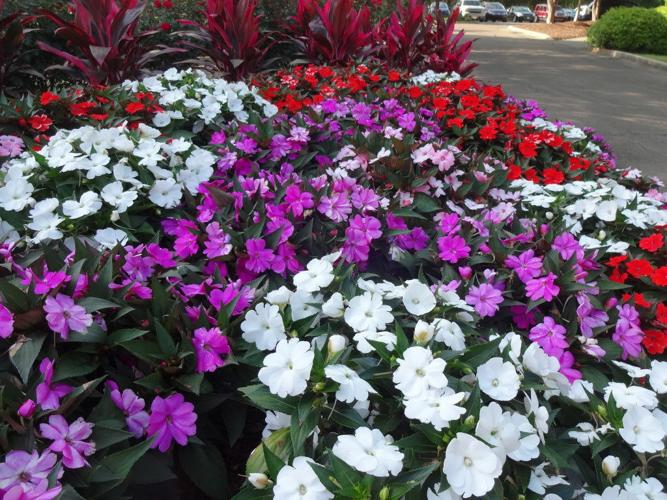
SunPatiens represent an innovative breakthrough in impatiens breeding, delivering the lush flowering habit of traditional impatiens with remarkable heat and sun tolerance. These vigorous hybrids thrive in conditions that would quickly diminish standard impatiens varieties.
Key characteristics:
- Exceptional heat and humidity tolerance unlike shade-loving impatiens
- Continuous flowering from spring planting through first frost
- Available in vibrant colors including white, pink, coral, red, and lavender
- Disease resistant, particularly to downy mildew that affects traditional impatiens
- Robust growth habit with plants reaching 24-36 inches in height and width
- Suitable for both containers and landscape plantings
- Requires less frequent watering than traditional impatiens
- Performs well in both full sun and partial shade locations
Design tip: Use SunPatiens to create season-long color in transitional areas that receive morning sun and afternoon shade. Their versatility makes them excellent choices for unified color schemes across varying light conditions in the same landscape.
10. COSMOS
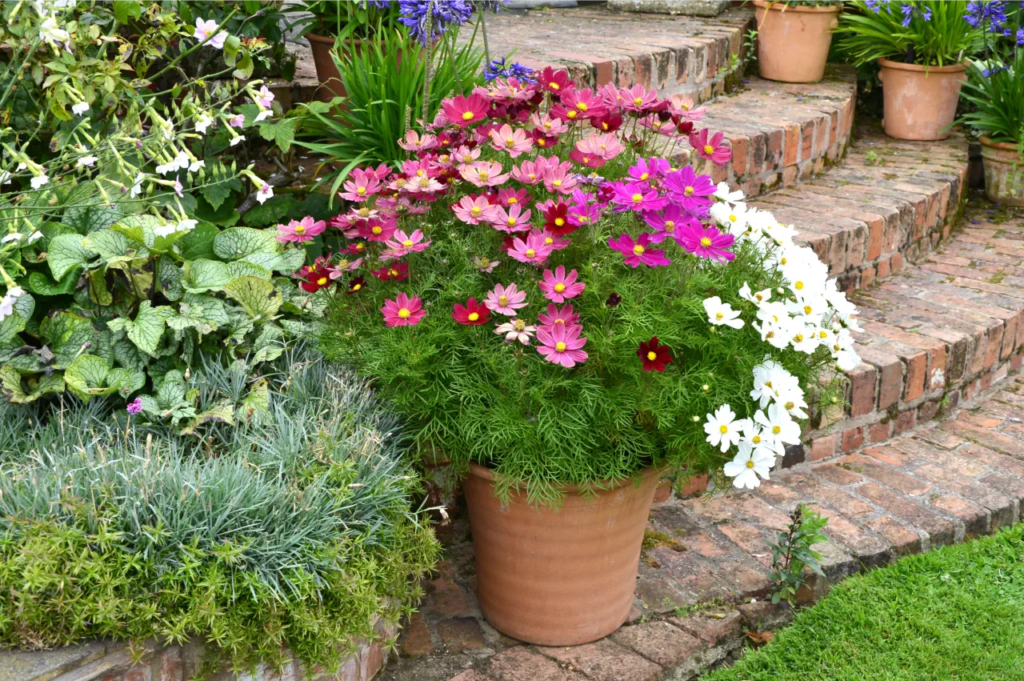
Cosmos offer airy elegance combined with exceptional durability, making them perfect for gardeners seeking carefree summer color. Their feathery foliage and daisy-like blooms create movement and lightness in garden designs.
Key characteristics:
- Easily grown from direct-sown seeds after danger of frost
- Available in shades of pink, white, red, and chocolate brown
- Excellent cutting flower with long, sturdy stems
- Drought-tolerant once established
- Height varies from dwarf varieties (18-24 inches) to tall forms (3-6 feet)
- Attracts beneficial insects and pollinators
- Low fertility requirements—often blooms better in poor soil
- Self-seeds readily for volunteer plants in subsequent seasons
Design tip: Plant cosmos in drifts toward the back of sunny borders where their height and movement create a naturalistic backdrop for shorter companions. Their open growth habit allows for underplanting with compact annuals like alyssum or dwarf marigolds for multi-level interest.
11. ANGELONIA
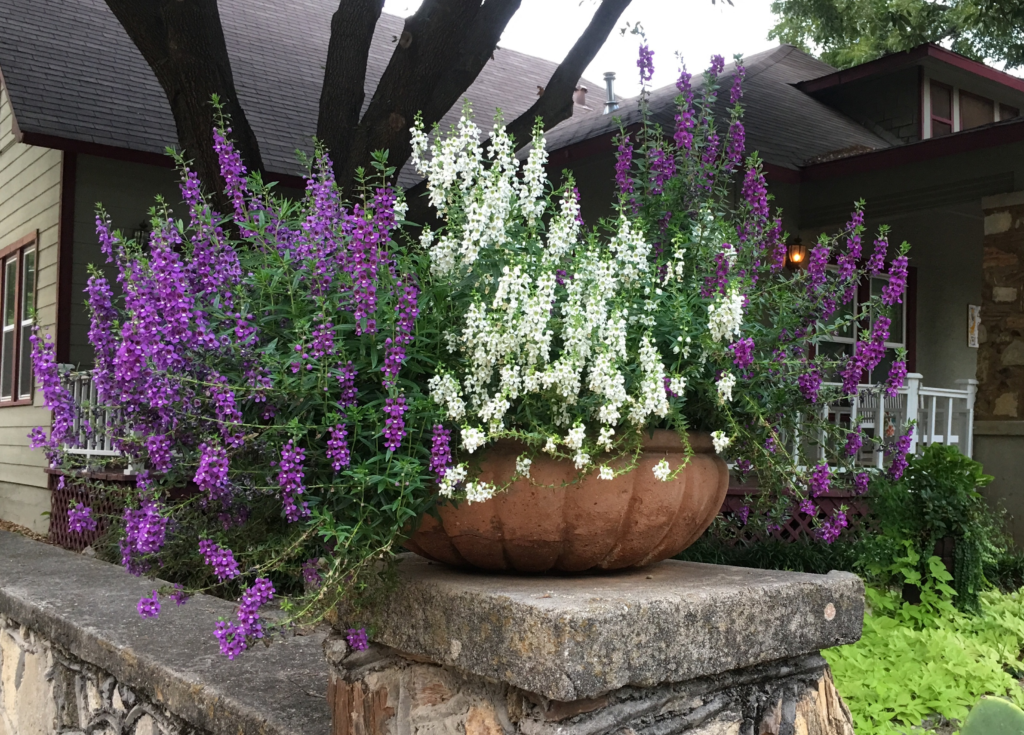
Often called summer snapdragon, angelonia delivers vertical interest with its spire-like flower stalks and exceptional heat tolerance. Unlike many summer annuals that fade in intense heat, angelonia actually intensifies flowering during hot periods.
Key characteristics:
- Outstanding heat and humidity tolerance
- Continuous flowering throughout summer without deadheading
- Available in white, pink, purple, and bicolor varieties
- Upright growth habit ranging from 12-24 inches tall
- Light, sweet fragrance when brushed or touched
- Drought-tolerant once established
- Resistant to deer and rabbit damage
- Attractive to butterflies but not susceptible to caterpillar damage
Design tip: Incorporate angelonia as a vertical accent in container compositions or as a mid-height filler in borders. Its architectural form provides structured contrast to more billowing companions like lantana or verbena, creating garden compositions with varied textures and forms.
12. LANTANA
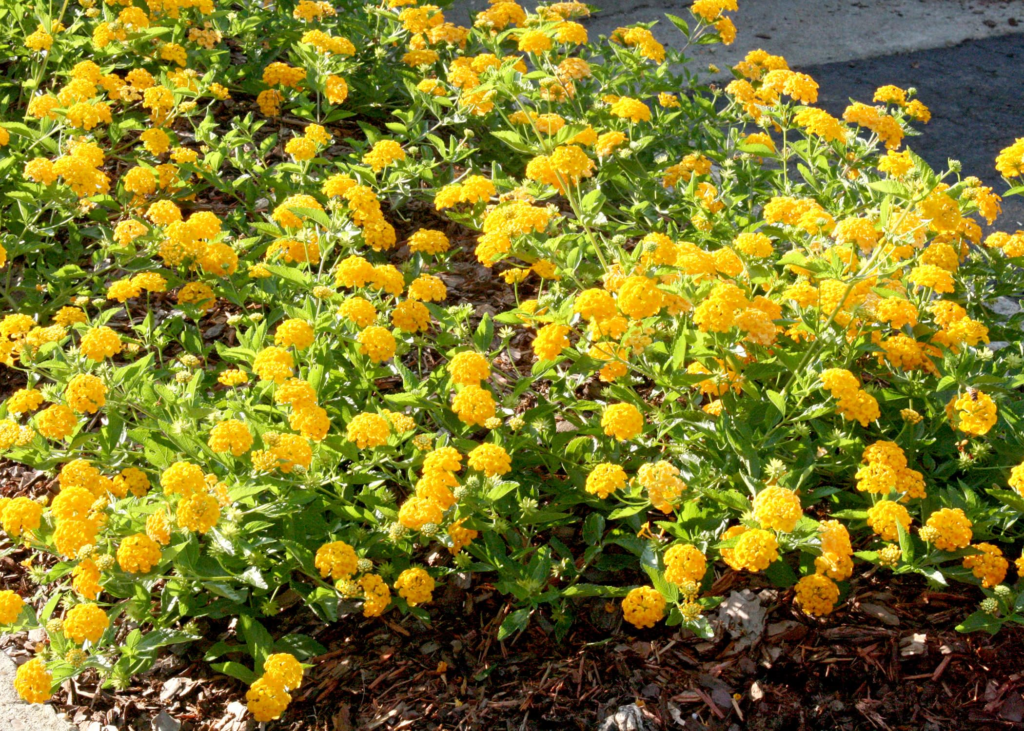
Lantana combines tropical flair with exceptional durability, delivering non-stop color even during the hottest summer periods. Its clustered flower heads often feature multiple colors that change as blooms mature, creating dynamic visual interest.
Key characteristics:
- Extraordinary heat and drought tolerance
- Continuous blooming without deadheading requirements
- Available in vibrant combinations of yellow, orange, pink, red, purple, and white
- Growth habits ranging from compact mounds (12-18 inches) to spreading forms (2-4 feet)
- Attractive to butterflies, hummingbirds, and beneficial pollinators
- Deer-resistant foliage with aromatic qualities
- Potential perennial performance in zones 9-11
- Fast-growing with quick establishment
Design tip: Use trailing lantana varieties in hanging baskets or as spilling elements in container gardens. For landscape applications, incorporate mounding varieties as low-maintenance groundcovers in challenging hot, dry locations where few other flowering plants will perform reliably.
13. VERBENA
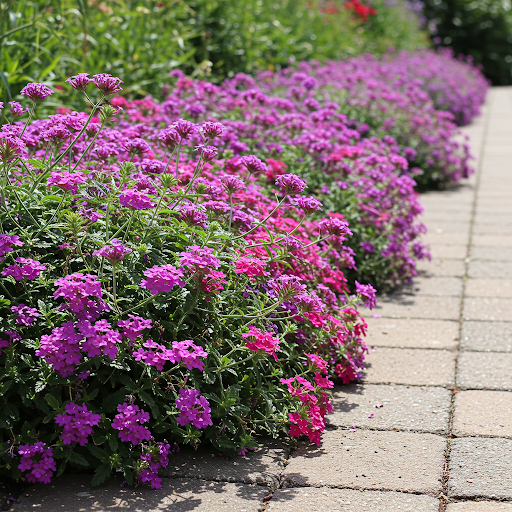
Verbena offers exceptional versatility with varieties suitable for containers, groundcovers, and vertical accents. Their clustered flower heads create concentrated color while attracting numerous beneficial pollinators to the garden.
Key characteristics:
- Excellent heat and drought tolerance once established
- Extended blooming period from spring through fall
- Available in shades of purple, blue, pink, red, and white
- Growth habits including low spreaders (8-12 inches) and upright forms (18-30 inches)
- Attracts butterflies and other beneficial pollinators
- Moderate to good deer resistance
- Many varieties offer subtle fragrance
- Performs well in average to poor soils with good drainage
Design tip: Plant low-growing verbena varieties along sunny border edges where they will cascade slightly over walls or walkways. Their dense flowering habit provides exceptional color impact while their spreading nature helps suppress weeds in these transitional zones.
14. CELOSIA
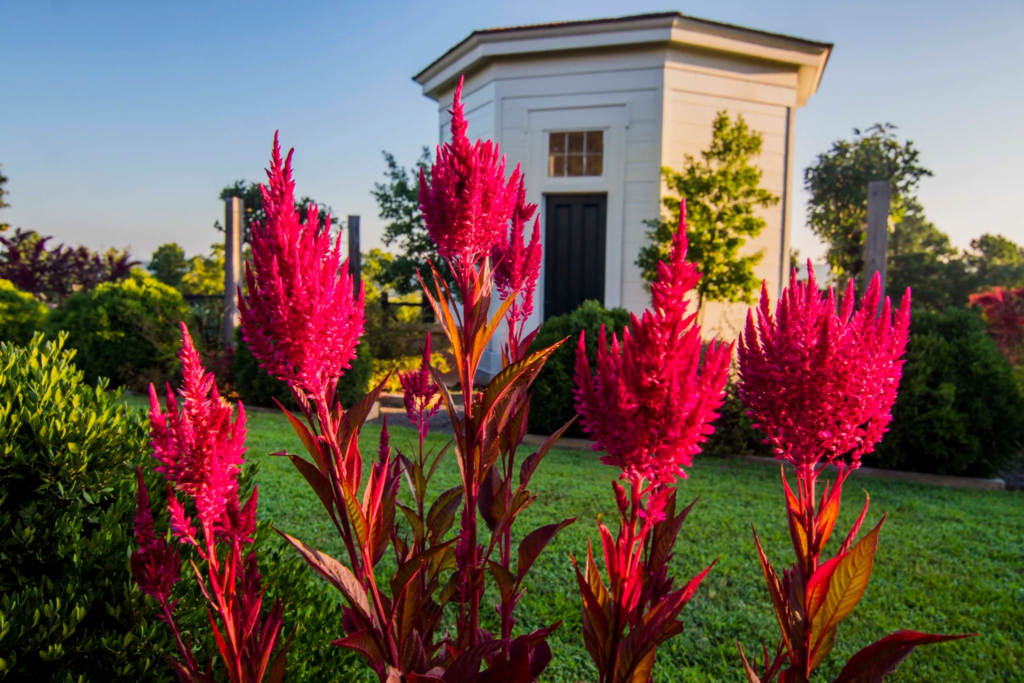
Celosia delivers bold textural elements with its distinctive flower forms, ranging from plumed varieties to crested cockscomb types. These unique annuals add architectural interest and vibrant color to both gardens and cut flower arrangements.
Key characteristics:
- Distinctive flower forms unlike any other garden annual
- Heat and humidity tolerance that improves with high temperatures
- Color range including fiery reds, oranges, yellows, pinks, and burgundies
- Height varieties from dwarf bedding plants (8-12 inches) to tall cutting types (36-48 inches)
- Excellent vase life as cut flowers, fresh or dried
- Drought-tolerant once established
- Minimal pest and disease problems
- Continuous blooming without significant deadheading requirements
Design tip: Incorporate celosia as textural focal points in annual beds, using their unique forms to create visual stopping points in flowing garden designs. Their architectural qualities make them excellent specimen plants in containers where their distinctive shapes can be appreciated up close.
15. SALVIA
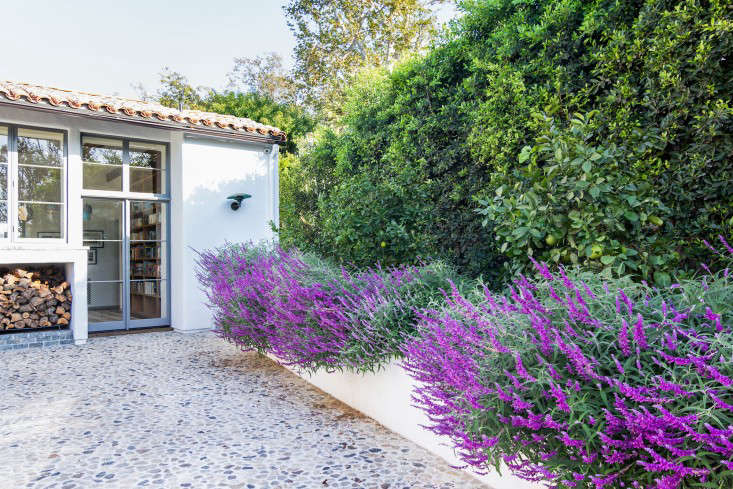
Annual salvias offer vertical architectural elements with their spire-like flower stalks and extended blooming season. Available in a stunning range of colors and sizes, these versatile plants attract pollinators while deterring many garden pests.
Key characteristics:
- Exceptional heat tolerance and drought resistance
- Continuous flowering with minimal maintenance
- Available in vibrant blues, purples, reds, pinks, and whites
- Height range from compact varieties (12-18 inches) to tall statements (24-36 inches)
- Attracts hummingbirds, butterflies, and beneficial pollinators
- Aromatic foliage naturally deters many garden pests
- Excellent cutting flowers with good vase life
- Performs well in average to poor soils with good drainage
Design tip: Use annual salvias to create rhythm and vertical movement through garden beds by repeating their distinctive spires at planned intervals. Their structural form provides excellent contrast to rounded flower shapes like zinnias or marigolds, creating dynamic visual interest throughout the growing season.
CONCLUSION
Full sun annuals offer gardeners an unmatched combination of immediate impact, extended seasonal color, and exceptional value. Their adaptability across growing zones and minimal establishment requirements make them perfect solutions for both beginning gardeners and experienced landscapers seeking reliable performance in challenging conditions.
When selecting annuals for your sunny spaces, consider not just color but growth habit, texture, and bloom time to create layered, dynamic garden compositions. By combining different plant forms—trailing, mounding, and upright—you can develop visually compelling landscapes that maintain interest throughout the growing season.
For maximum impact with minimal effort, consider these professional strategies:
- Group similar colors in large masses rather than creating “polka dot” plantings of individual specimens. This approach creates bold visual statements visible from a distance.
- Incorporate varying heights and textures to create depth and visual movement within your garden beds.
- Select varieties with complementary water and fertilizer needs to simplify maintenance routines.
- Incorporate both early and late-season performers to extend your garden’s peak beauty period.
- Don’t overlook foliage interest when selecting your full sun annuals—silver-leaved dusty miller or colorful coleus can provide structure even when flowering slows.
With thoughtful selection and placement, these 15 sun-loving annuals can transform ordinary spaces into extraordinary gardens that deliver months of vibrant color and texture. Whether you’re filling containers, designing borders, or creating cutting gardens, these versatile plants offer solutions for every sunny garden situation while providing exceptional return on both your financial investment and gardening effort.

